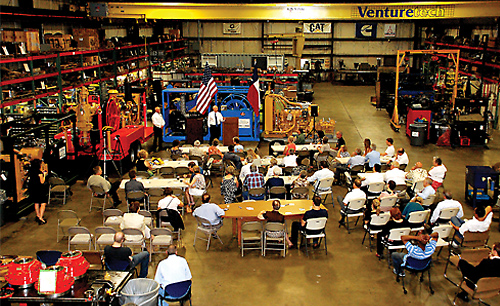Thinking Outside the Box to Fulfill Workforce Needs
Some businesses are looking to nontraditional labor pools — including ex-offenders, recovering addicts, and those with disabilities — as potential employees.
Workforce Q2 2018

For about 20 years, engineer Larry Keast has been hiring skilled employees with “backgrounds” — a prison record and/or a past addiction — to work at Houston-based Venturetech, the company he founded in 1980. The first one was an ex-convict-turned-drug counselor (and former oilfield worker) Keast met at a treatment center where Keast was leading a parents’ group. The man went on to spend seven productive years at Venturetech, working his way up to shop boss.
“[The shop boss] would find people from AA and other recovery groups – including machinists, mechanics, welders, truck drivers — and we would hire them,” says Keast. At times, as many as 40 percent or more of Venturetech’s employees have been people with “backgrounds,” Keast notes. (The company has never had more than 60 employees total, based on the fluctuating business health of the energy industry.)
Relying on personal recommendations, Keast doesn’t have set criteria for hiring. “You should believe in people; what have you got to lose, as a small company? We let the general manager decide, and he generally wants the opinion of a foreman. You’re going to find out if they work out within a week or two, and you’re not going to risk much.”
It doesn’t always work out, but the turnover rate of employees with “backgrounds” has been no higher than the rank and file, Keast says. “It’s always hard to find good people. We have hired good people when they came out of prison, and they are generally very grateful to have a job. They have a tremendous attitude, and it rubs off on all of us.”
Keast also founded a nonprofit called America in Recovery, which gives college scholarships to needy but deserving youth in the local community.
Soon-to-be-Released Inmates
Some local correctional centers have started programs to help get soon-to-be-released inmates ready for employment. In March, a program at Rutherford County (Tenn.) Correctional Work Center that trains soon-to-be-released inmates for the workplace graduated its first group of 12 men. The Rutherford County Project Second Chance job training program provides currently incarcerated individuals, who are 90–120 days away from completing their sentence, the opportunity to gain the manufacturing industry training and certifications needed to have a meaningful and sustainable career path in the local workforce.
In the roughly 10 years that Bryan Scott has owned Barn Light Electric LLC in Melbourne, Fla., he has hired nearly 50 ex-offenders to work at his company. His firm was still a startup when he hired the first two, whom he met when they were doing some construction work on his manufacturing plant. “They seemed like really decent people who had turned their lives around, but they said nobody would give them a (permanent) job. I hired them, and they turned out to be really good employees.”
Scott, who previously spent 25 years working in law enforcement, says not all of the ex-convicts he hires work out. But many of them have turned out to become some of his “most loyal and dedicated employees, because I trusted them.”
Many of his ex-offender hires came to the company through word of mouth. He also works with local nonprofits that place ex-offenders, homeless vets, and other people who are recovering from addiction. A large percentage of the ex-convicts have dealt with addictions underlying their criminal records, he notes.
It’s always hard to find good people. We have hired good people when they came out of prison, and they are generally very grateful to have a job. They have a tremendous attitude, and it rubs off on all of us. Larry Keast, petroleum engineer, Venturetech Drilling Technologies One hiring criteria is that Scott only considers ex-offenders who have had clean records for at least a year. One of the keys to helping them succeed in the workplace is having supervisors with similar backgrounds who can mentor them and monitor their progress, once they have been hired, Scott notes. “In a tight job market, it’s a chance to bring on some good employees you wouldn’t otherwise get.”
The international campaign called Ban the Box has made it easier for some ex-offenders to find work, by persuading employers to remove from their hiring applications the check box that asks if applicants have a criminal record. Its purpose is to enable ex-offenders to show their qualifications in the hiring process before being asked about their criminal records. The campaign is based on the idea that anything that makes it harder for ex-offenders to find a job makes it likelier that they will re-offend.
According to the National Employment Law Project, 31 states and over 150 cities and counties have adopted what is widely known as “ban the box” so that employers consider a job candidate’s qualifications first — without the stigma of a conviction or arrest record. Eleven states — California, Connecticut, Hawaii, Illinois, Massachusetts, Minnesota, New Jersey, Oregon, Rhode Island, Vermont, and Washington — have also mandated the removal of conviction history questions from job applications for private employers, a change that advocates embrace as the next step in the evolution of these policies.
Workers With Disabilities
Skilled workers who have disabilities are another category that employers can tap into. Hiring skilled people with disabilities “is not about charity; it’s a business decision,” says Joyce Bender, a Pittsburgh-based consultant who helps companies tap into that labor pool. The tight job market has made more companies recruit employees with disabilities, she says. One of Bender’s clients, the National Security Agency “saw years ago that we needed another labor pool. They have hired people in math, engineering, IT, finance — many of those STEM areas where employers have trouble finding people.”
Studies have shown that disabled employees tend to have “the best attendance records,” Bender says. They have learned what it means to be a team player, who thinks outside the box.” They also tend to have “great attitudes,” and gratitude about being hired, she says.
Studies have shown that disabled employees tend to have the best attendance records. They have learned what it means to be a team player, who thinks outside the box. They also tend to have “great attitudes,” and gratitude about being hired. Joyce Bender, Pittsburgh-based consultant Bender advises employers who would like to recruit skilled employees with disabilities to “have their HR department put together a dedicated plan for recruitment. They should also look at their suppliers” to find out if they have inclusive hiring practices. “People with disabilities want paychecks, not pity,” says Bender, who has herself experienced disability in the form of hearing loss and epilepsy.
The U.S. Department of Labor’s Office of Disability Employment Policy (ODEP) supports several initiatives that help employers interested in hiring individuals with disabilities, including the Employer Assistance and Resource Network on Disability Inclusion (EARN), a free, nationwide service that educates employers about effective strategies for recruiting, hiring, retaining, and advancing people with disabilities.
EARN also maintains a list of job posting websites geared toward job-seekers with disabilities and a collection of success stories about employers that have made a commitment to disability inclusion. The Workforce Recruitment Program for College Students with Disabilities (WRP) is a free resource that connects private businesses and federal agencies nationwide with qualified job candidates for temporary or permanent positions in a variety of fields.
Through WRP jobs, private employers interested in gaining access to these individuals can post permanent and temporary positions. WRP participants can then search and apply for these positions using an employer’s standard application processes. And the Job Accommodation Network (JAN) provides free, expert advice on workplace accommodations that may be necessary to assist qualified individuals with disabilities apply for a job and maximize their productivity.
Since 2007 Illinois-based Walgreens has successfully implemented a disability inclusion strategy; today, 10 percent of employees now have some form of disability. This strategy has resulted in increased loyalty (both employee and customer), lower employee turnover, better attendance, and improved psychological safety and corporate reputation. For example, turnover at Walgreen’s Connecticut Distribution Center was reduced to 15 percent (compared to 55 percent in other distribution centers, which is driven by the repetitive nature of the job). Increased loyalty of employees with a disability was identified not only by the reduced turnover but also by the increase in discretionary effort, with many employees turning up to work between 15–20 minutes before their shift, and reduced absenteeism.
Valentini Kalargyrou, a University of New Hampshire researcher, studied the perceived impact and benefits of disability-focused inclusion activities, in the context of Walgreen’s and one other company in the hospitality sector. Kalargyrou says that despite some of the challenges (like equal productivity standards for all, and creating a safe workplace environment for people with a disability), the positive impacts on employee turnover, loyalty, attendance, and psychological safety — both within the target employee group and beyond — have been significant.
Kalargyrou identified the organizational practices that helped maximize the full potential of individuals with disabilities at Walgreen, such as alliances with local disability partners; creating a supportive culture and safe work environment; investing in manager training and awareness about working with team members with disabilities; generating transparent discussion; and creating fair and equal opportunities for different roles, particularly “customer-facing” roles.
Project Announcements
Ninth Avenue Foods Plans Longview, Texas, Production Operations
12/06/2025
LayerZero Power Systems Expands Streetsboro, Ohio, Manufacturing Operations
12/06/2025
BioStem Technologies Plans Boca Raton, Florida, Headquarters Operations
12/06/2025
Saronic Technologies Expands St. Mary Parish, Louisiana, Operations
12/05/2025
JGA Space and Defense Expands Huntersville, North Carolina, Operations
12/05/2025
SODECIA-AAPICO Plans Orangeburg, South Carolina, Manufacturing Operations
12/05/2025
Most Read
-
Rethinking Local Governments Through Consolidation and Choice
Q3 2025
-
First Person: Filter King’s Expansion Playbook
Q3 2025
-
Rethinking Auto Site Strategy in the Age of Tariffs and Powertrain Shifts
Q3 2025
-
Lead with Facts, Land the Deal
Q3 2025
-
How Canada Stays Competitive
Q3 2025
-
America’s Aerospace Reboot
Q3 2025
-
The Permit Puzzle and the Path to Groundbreaking
Q3 2025


